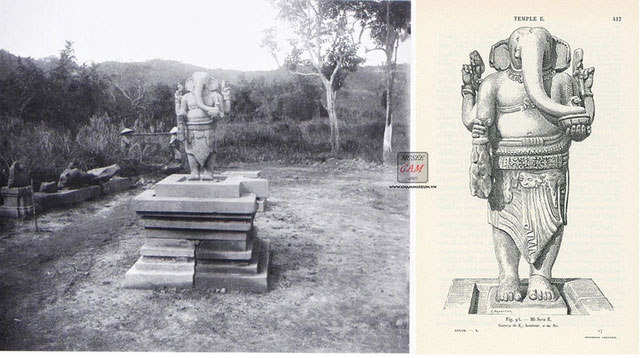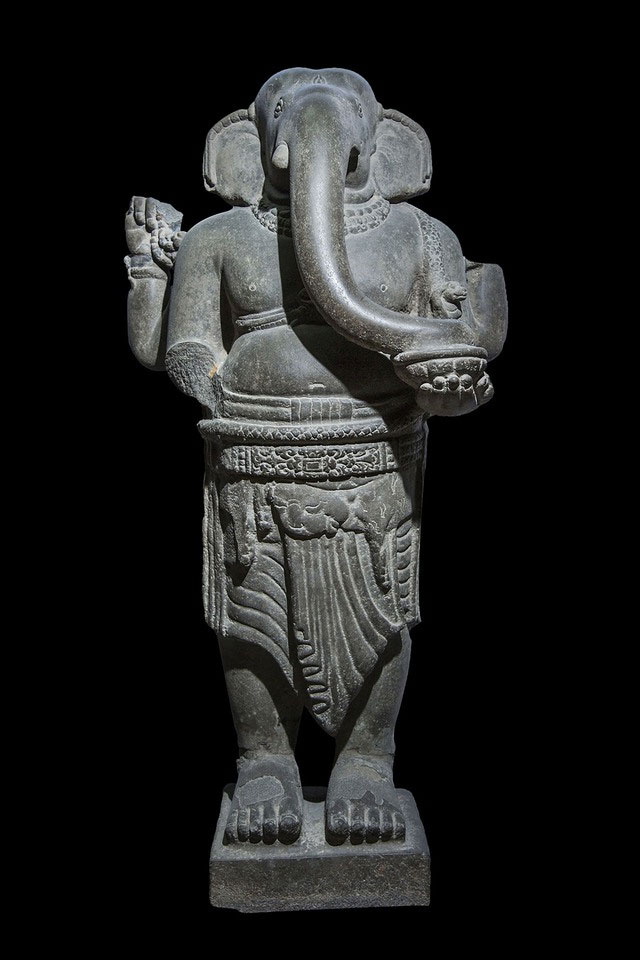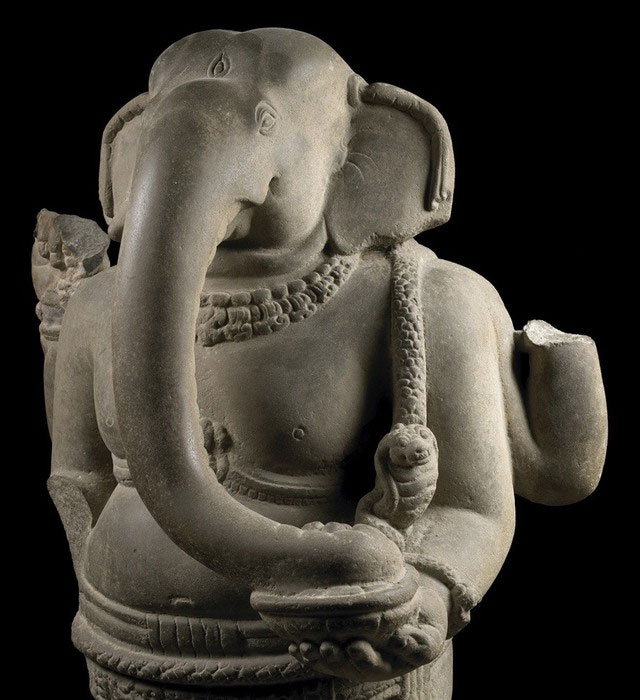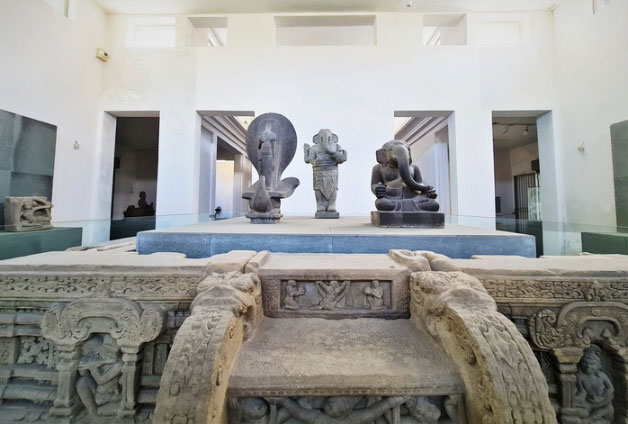The Da Nang Museum of Cham Sculpture currently holds a very special national treasure. Every time this artifact is brought abroad, it is insured for nearly 1 million USD.
Find the statue
According to Tuoi Tre newspaper , in 1903, the French Institute of the Far East (EFEO) led by two archaeologists, Mr. L.Finot and H.Parmentier, during a survey at My Son Sanctuary, Quang Nam province, found a painting. statue at temple – tower E5. Archaeologists determined that this is a statue of Ganesha belonging to group E (according to the grouping method of French archaeologists at that time).

In 1903, the French Institute of the Far East (EFEO) found a statue of Ganesha at the My Son sanctuary. (Photo: Da Nang Museum of Cham Sculpture)
According to national treasure records, this Ganesha statue is made of blue-gray sandstone, 95cm high, 48cm long, and 34cm wide. It is shown standing upright, looking forward, and has four arms. Currently, only the left main arm and the right secondary arm remain, the remaining two arms have had their elbows and hands broken. The main left hand holds the shallow bowl, the spout is dipped into the bowl, while the secondary right hand holds the rosary. This bowl is a Modak honey bowl , a detail often found in early-dating elephant god statues.
In a photo painted in 1909 by H.Parmentier, the left hand holds a small ax, and the right hand holds a bunch of leaves that elephants like to eat. The small ax is a common detail in early elephant god statues. The cluster of leaves is believed by art researchers to be a characteristic of early works depicting Ganesha statues in Southeast Asia.
 According to national treasure records, this Ganesha statue is made of blue-gray sandstone, 95 cm high, 48 cm long, and 34 cm wide. (Photo: Labor Newspaper).
According to national treasure records, this Ganesha statue is made of blue-gray sandstone, 95 cm high, 48 cm long, and 34 cm wide. (Photo: Labor Newspaper).
Later, this statue was brought to the Da Nang Museum of Cham Sculpture in 1918. It has become one of the important artifacts proving the early introduction of Hinduism into the Champa kingdom.
The meaning and importance of the statue
Lord Ganesha in Hinduism is an important and widely worshiped deity . There are many stories about the birth of Lord Ganesha. One of the most popular stories tells that Mother Parvati, the wife of Lord Shiva, created Ganesha from the algae of her body. When Shiva returned and wanted to go inside, Ganesha stopped him. Shiva did not recognize Ganesha and beheaded the boy. Later, when Parvati came to know this, she asked Shiva to place a new head on Ganesha. Shiva chose the head of an elephant, and from there Ganesha got this unique shape.
Ganesha is considered the god of intelligence, knowledge and luck. Ganesha’s elephant head is said to symbolize the ability to remove obstacles and overcome difficulties. This is why people often worship Ganesha before starting anything new.
Ganesha is also considered a protective god, preventing disasters and bringing good luck. His elephant head is said to have the ability to see far and hear well, helping to protect and ensure the safety of humans.
 The Ganesha statue at the Da Nang Museum of Cham Sculpture is an important artifact that demonstrates the early introduction of Hinduism to the Champa kingdom. (Photo: Labor Newspaper).
The Ganesha statue at the Da Nang Museum of Cham Sculpture is an important artifact that demonstrates the early introduction of Hinduism to the Champa kingdom. (Photo: Labor Newspaper).
Ganesha is often depicted as cheerful, friendly and humorous. The image of an elephant’s head also represents the diversity and creativity in Indian culture and beliefs.
In short, the unique appearance of Ganesha with an elephant head is an important part of Indian beliefs and culture, and it carries with it many spiritual meanings and values.
Information from the People’s Public Security newspaper, the statue has typical features of the Thap Mam style, around the 12th – 13th centuries, during the development of Champa sculpture art. In addition, the Ganesha statue at the Da Nang Museum of Cham Sculpture is an important artifact demonstrating the early introduction of Hinduism into the Champa kingdom. These are unique original artifacts, with unique forms and special values that represent the religious art of Champa through the ages.
National treasure insured for millions of dollars
On December 31, 2020, the Genesha statue was signed by the Prime Minister to recognize the 9th national treasure. Not only has cultural and spiritual value, the Genesha statue is often recognized by museums. borrowed from around the world to display in large-scale exhibitions. Every time it is brought abroad, this national treasure is insured for nearly 1 million USD. This shows the special value of this statue.
In 2005, this artifact was brought to France for exhibition at the Guimet National Museum of Asian Art, Paris with an insured value of 800,000 USD (nearly 24 billion VND at the current exchange rate) according to the insurance contract commitment. of the French side. In 2014, the artifact was brought to the US for exhibition at the Metropolitan Museum, New York with an insurance value of 800,000 USD (nearly 24 billion VND at the current exchange rate) according to the American side’s insurance commitment.
 The Genesha Statue has been recognized by the Prime Minister as a national treasure. (Photo: Nguoi Lao Dong Newspaper).
The Genesha Statue has been recognized by the Prime Minister as a national treasure. (Photo: Nguoi Lao Dong Newspaper).
With a combination of myth, meaning and cultural value, the Ganesha statue at the Da Nang Museum of Cham Sculpture is not only a work of art, but also a part of the Champa cultural heritage. Da Nang Museum of Cham Sculpture (Hai Chau district) is preserving and displaying 6 National Treasures and more than 2,000 large and small artifacts of Champa culture.





